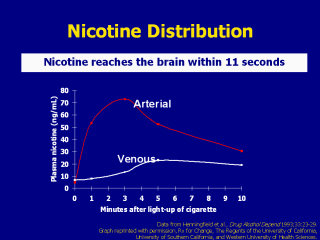| front |1 |2 |3 |4 |5 |6 |7 |8 |9 |10 |11 |12 |13 |14 |15 |16 |17 |18 |19 |20 |21 |22 |23 |24 |25 |26 |27 |28 |29 |30 |31 |32 |33 |34 |35 |36 |37 |38 |review |
 |
Inhalation of tobacco smoke is an effective
means of delivering nicotine to the central nervous system. After
inhalation, nicotine is rapidly absorbed across pulmonary epithelium into
the arterial circulation, traveling via the carotid arteries to the central
nervous system. Nicotine readily penetrates the blood-brain barrier,
resulting in transient exposure of the brain to high levels of nicotine.
Nicotine has been estimated to reach the brain within 11 seconds of
inhalation. Following systemic distribution, brain nicotine levels decline
rapidly (Benowitz, 1990). This graph depicts the arterial and venous concentrations of nicotine achieved during cigarette smoking. Within one minute after smoking a cigarette, arterial levels of nicotine are nearly seven times the corresponding venous levels (Henningfield et al., 1993). These rapid, high levels of nicotine in the central nervous system produce an almost immediate effect thereby reinforcing the behavioral act of smoking which further stimulates repeated administration. Benowitz NL. Clinical pharmacology of inhaled drugs of abuse: Implications in understanding nicotine dependence. In Chiang CN, Hawks RL (eds.): Research Findings on Smoking of Abused Substances, NIDA Research Monograph 99. Rockville, MD: 1990. Available at: http://www.drugabuse.gov/pdf/monographs/download99.html [Accessed February 14, 2003] Henningfield JE, Stapleton JM, Benowitz NL, Grayson RF, London ED. Higher levels of nicotine in arterial than in venous blood after cigarette smoking. Drug Alcohol Depend 1993;33:23-9. Slide is used with permission, Rx for Change: Clinician-Assisted Tobacco Cessation. Copyright © 1999-2007 The Regents of the University of California, University of Southern California, and Western University of Health Sciences. All rights reserved. |